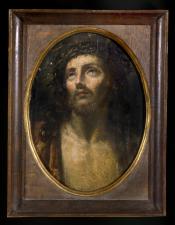Ecce Homo
The subject
This image represents one of the most famous episodes of Christ’s life: the moment when Jesus, after being flogged, mocked and crowned with thorns, has been shown to people who was asking for Him to be crucified.
This episode was narrated by John, on his gospel:
“So Jesus came outside, wearing the crown of thorns and the purple robe. Pilate said to them «Look, here is the man! (Ecce Homo)»” . (John 19, 5)
The painting
Chronologically, this painting can be collocated between 16th and 17th century, in the area around Bologna.
The visage of Christ presents a flush tone and he has a composed suffering expression: he’s looking to heaven, completely careless of his bleeding wounds. This iconographical version was coming from a catholic environment. In other versions, coming from school of northern Europe, Jesus Christ was represented on the moment of maximum physical suffering to underline his human nature compared with the divine one as theorized by the new protestant doctrines which were spreading across Europe since the beginning of 16th century.
On the back of the panel there’s an ink writing quite indecipherable. Few words are readable:
- The first one is a referent to one of Carracci brothers (Agostino or Annibale, followed by a date, 1585)
- The second referent is to Raphael’s room (probably referred to Raphael Vatican’s room frescoes)
The inscription ends with a date: 1859.
For dimensions and typology of the subject it’s quite likely that this panel has been made for a private worship.







